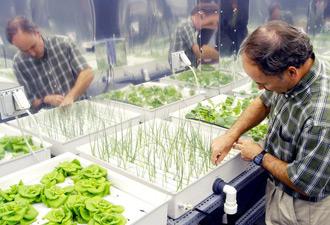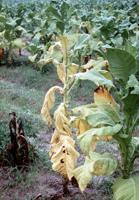3 Disadvantages of Traditional Agriculture — And How Hydroponics Fixes Them

When I was in kindergarten, my class took a trip to a local farm.
For most of my class (myself included), this was the first time we had ever been on a farm. The teachers and parents could have mistaken us for the animals — that’s how rowdy we were.
Up until then, the only farms we had seen were in picture books, where the farmers, animals, and plants usually all had big eyes and smiling faces. As a young kid, we were taught that farms are positive places, where animals, plants, and farmers all work together to grow our food. After all, you can see their wide tooth-filled grins in picture books.
As we grow up and things acquire more of an eye for shades of grey, we begin to see that agriculture is not the smile-filled world of youth, but something which has both advantages and disadvantages.
Having attended New Food Revolution last week, I’ve spent the past week thinking a lot about the disadvantages, such as environmental pollution, water scarcity, and land use, and about how hydroponic growing techniques could mitigate them. Although I don’t think that hydroponic and vertical farming could ever totally replace our need for soil, I think that shifting as much of our food production as possible to hydroponics could have its advantages.
Nitrate runoff

Fertilizer runoff can result in algal blooms in lakes and rivers. The algae uses up all the oxygen, causing massive fish deaths.
Nitrogen is the most important nutrient for plants, and while it’s abundant on Earth (70% of our atmosphere is Nitrogen gas), plants can only absorb it in the form of nitrates. Farmers use fertilizers to provide plants nitrogen in this form, but dissolved nitrates that are put into the ground eventually find their way back to the groundwater, which is used for drinking water. Unfortunately, you can’t drink this water (to explain why, consider that your urine is mostly nitrates dissolved in water).
Hydroponic growing addresses this problem in two ways. Firstly, by the time they’re ready for disposal, hydroponic nutrients have been feeding plants for at least two weeks, meaning they’re simply weaker than normal fertilizer. Secondly, since hydroponics is a recirculating system, waste water never inadvertently finds its way into the environment. Disposal is a carefully controlled process where the grower drains the nutrient tank into a waste water tank and then has the chance to treat the water. Treating the water can be as simple as using the nutrient solution to grow weeds or low-nutrient requiring plants.
Nutrient solution is also the perfect growing environment for algae. With a small air stone and some space, it would be possible to use the waste water to grow algae. As the algae grew, they would use the nutrients in the water, slowly purifying the water. The algae could then be harvested to produce biofuel, or other algal products. The diagram below depicts such a hypothetical “algae farm”.

Used hydroponic nutrients could be used to grow algae in a so-called “bioreactor.”
The algae would filter the water as they absorbed the dissolved solids. After sterilization, the water could be re-used. The algae could be harvested to
create biofuel.
Copyright © 2008 HowStuffWorks.com
Copyright © 2008 HowStuffWorks.com
Water Usage
Agriculture is currently the single largest consumer of fresh water in the world. Since fresh water is always in limited supply, any water used for agriculture is water that we aren’t able to drink or store. Big farms consume so much water that they can run groundwater wells dry, meaning that when drought inevitably strikes, its effects are heightened. The effects here aren’t only environmental; groundwater depletion has economic effects as well. According to California Secretary of Agriculture Karen Ross, the current drought in California has affected over 17,000 jobs.
Hydroponics solves this issue by using up to 90% less water than traditional agriculture. This phenomenon has nothing to do with hydroponics; it’s a common savings in a recirculating agricultural system. By continuously re-using the same water, these systems eliminate the need for a constant supply of fresh water to be pumped out of the ground. This is good economically too. Water is one of the largest inputs to an agricultural operation, so optimizing the amount of crop produced per gallon is essential to controlling costs.
Proliferation of Pests

Fusarium wilt is an incurable plant disease caused by the Fusarium fungus. Once introduced into a patch of soil, the virus quickly spreads and produces spores that can reside in the soil up to 20 years, rendering the land unusable
Pests are currently a large and growing problem for traditional soil-based growers. Worms, beetles, and other insects that prey on plants thrive in traditional farms. Bacterial, viral, and fungal diseases continually evolve to infect even disease-resistant strains of crops. According to the EPA, American farmers used almost 877 million pounds of pesticides in 2007. The US has about 408 million acres of farmland, so that’s about 2 pounds an acre. These pesticides later run off into our rivers and groundwater, making them unusable for drinking.
Because hydroponics uses no soil or even media in some cases, pests that live out their lifecyle in the soil are simply eliminated. Although hydroponic crops are still susceptible to bacterial, viral, and fungal diseases, growers can limit the ability of these organisms to infect plants by sterilizing the nutrient solution, using either UV or hydrogen peroxide. Once again, the economic benefits are clear: hydroponic growers do not need to be as afraid of catastrophic crop failure due to invasive pests.
Disadvantages
However, hydroponics doesn’t have all the answers – yet. You may have noticed that I did not include greenhouse gas emissions on this list. That’s becuase it’s not immediately clear if current hydroponic growing techniques really net out to zero greenhouse gas emissions. Sure, many people have However, hydroponics allow us to achieve a degree of control over plant nutrition and metabolism unattainable in soil-based systems, so scientific advances may lead to true carbon neutrality.